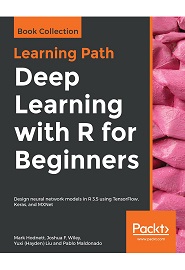
English | 2019 | ISBN: 978-1838642709 | 612 Pages | EPUB | 41 MB
Explore the world of neural networks by building powerful deep learning models using the R ecosystem
Deep learning finds practical applications in several domains, while R is the preferred language for designing and deploying deep learning models.
This Learning Path introduces you to the basics of deep learning and even teaches you to build a neural network model from scratch. As you make your way through the chapters, you’ll explore deep learning libraries and understand how to create deep learning models for a variety of challenges, right from anomaly detection to recommendation systems. The book will then help you cover advanced topics, such as generative adversarial networks (GANs), transfer learning, and large-scale deep learning in the cloud, in addition to model optimization, overfitting, and data augmentation. Through real-world projects, you’ll also get up to speed with training convolutional neural networks (CNNs), recurrent neural networks (RNNs), and long short-term memory networks (LSTMs) in R.
By the end of this Learning Path, you’ll be well versed with deep learning and have the skills you need to implement a number of deep learning concepts in your research work or projects.
This Learning Path includes content from the following Packt products:
- R Deep Learning Essentials – Second Edition by Joshua F. Wiley and Mark Hodnett
- R Deep Learning Projects by Yuxi (Hayden) Liu and Pablo Maldonado
What you will learn
- Implement credit card fraud detection with autoencoders
- Train neural networks to perform handwritten digit recognition using MXNet
- Reconstruct images using variational autoencoders
- Explore the applications of autoencoder neural networks in clustering and dimensionality reduction
- Create natural language processing (NLP) models using Keras and TensorFlow in R
- Prevent models from overfitting the data to improve generalizability
- Build shallow neural network prediction models
Resolve the captcha to access the links!